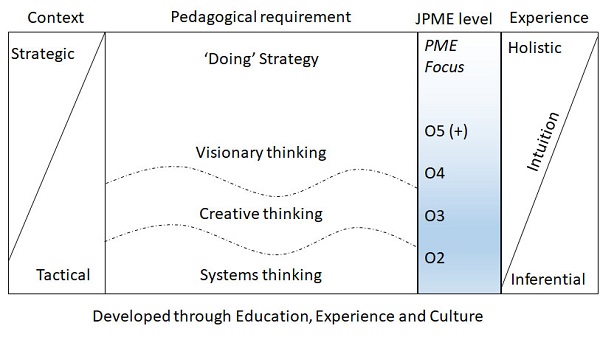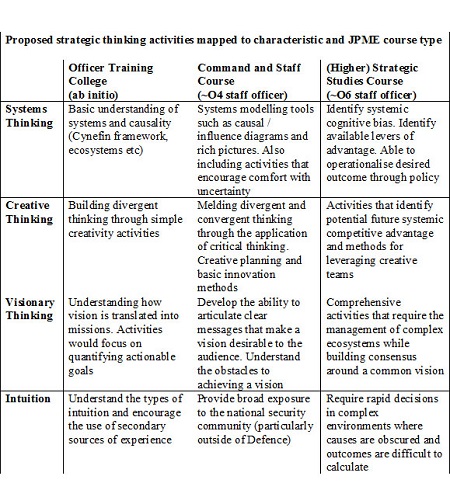Applying a Generalised Strategic Thinking Model to ADF Joint Professional Military Education
Leon Young and Timothy Keeffe
This research was, in part, supported by an Australian Army Research Grant and will result in a longer guide to developing strategic thinking in professional education programs.
This short article is intended to inform the development of strategic thinking in the Joint Professional Military Education (JPME) continuum. It will propose a strategic thinking framework and possible scaffold.
A Lack of Strategic Thinking
Strategy is popular. And for good reason. There is no ‘subject is more essential in the preparation of national security professionals and military leaders than the teaching of strategy’[1]. Equally, strategic thinking is often cited as being one of the most important abilities to foster within organisations. It is regarded as one of the core requirements of senior civil service employees and the mastery of strategic thinking is one of the pillars of future competitive advantage[2]. However, despite the touted importance of both strategy and strategic thinking, the majority of CEOs cited the ‘lack of strategic thinking as the main problem in their organisations’[3]. In fact, the UK Chief of Defence Staff, Sir Jock Stirrup, proclaimed that the UK had ‘lost an institutionalised capacity for, and culture of, strategic thought’[4].
The outcomes of poor strategic thinking capabilities are evident in recent conflicts. As reported by RAND and observed by Maher
The JPME Does Not Promote Strategic Thinking
The current approach to developing strategic thinking capabilities focusses on a small group of officers who have been selected for promotion and targets that development at very specific points in an officer’s career. This model reinforces the errors observed in strategic thinking development in a broader context. A 2015 article in Strategic Direction identified five key flaws in the development of strategic thinking in professional education programs[8]:
- Focus on outcomes, not skills and behaviours. This reflects an approach which prioritises results over process.
- Strategic thinking is seen as an elite activity, the sole preserve of senior leaders.
- Strategic thinking development is ad hoc. While organisations (such as Army) have formal education and training, the focus on strategic thinking has been uncoordinated.
- Organisations favour experience rather than conceptualization. In Army this is borne out by ‘old-school’ anti-intellectualism[9].
- A lack of evaluation of strategic thinking development, reflecting an in ability to relate methodology and efficacy.
Finally, while less evident in contemporary operations, Milan Vego (2013) warns of the rigidity and lack of tactical creativity which can lead to strategic failure[10]. Vego traces the failure of the French Army in World War 2 to instances where ‘the French Army became more rigid, by applying the rules of its doctrine almost without exception, regardless of the circumstances’. Such rigidity, the antithesis to creativity required in strategic thinking, resulted in strategic failure of the Army under the weight of German invasion in 1940.
Strategic Thinking Can be Identified Through Specific Indicators
Strategic thinking, as opposed to planning, is a way of thinking that seeks to create future competitive value[11]. It differs from tactics in two significant ways. Firstly, strategic thinking is concerned about system wide changes that are often realised over long time frames. Secondly strategic thinking is concerned with ongoing advantage (tactics is only concerned with winning). While only evident in retrospect, we can infer strategic thinking capacity from four key cognitive characteristics[12]:
- Visionary Thinking: Genuine visionary thinking provides a desirable and plausible sense of direction and a focus of organisational activities.
- Holistic Intuition: Differing to inferential intuition (expert judgement), holistic intuition is where judgements are based on qualitatively non-analytical process made by integrating multiple, diverse informational cues into a whole that may or may not be explicit.
- Creative Thinking: While the creation of novel ideas is central to the idea of creative thinking, ideas also need to be valuable. This requires both a divergent and convergent thinking style.
- Systems thinking: Strategic thinkers are often lauded for their ability to understand the broad relationships between often disparate entities. The ability to understand internal and external systems and evaluate the flow-on effect of specific actions is critical to evaluating future options.
Longitudinal Development Requires Long-term Utility
The JPME continuum is designed to consecutively develop Officers decision making abilities in the Joint Force at the tactical and strategic levels. Unfortunately, the cognitive requirements in these contexts differs. For example, one of the most significant requirements of tactical decision making (sometimes referred to as naturalistic decision making) is meta-recognition[13]. Meta-recognition rests on the ability to recognise a situation as similar to a previous experience. Thus, an officer requires a high volume of similar experiences to build appropriate tactical decision-making responses. This response heuristic is known as inferential intuition. While not useful for strategic thinking, inferential intuition can assist with the development of holistic intuition if the variety of experience is gradually built.
Tactical decision making relies on an understanding of probable cause and effect. That is, the decision makers observe cause A and infers that effect B is most likely. Alternatively, another effect is possible. As well as a solid foundation of relevant experience types, this type of thinking would naturally require a basic understanding of systems (cause and effect) and, due to an increasingly complex environment, creative thinking. It is now possible to infer some commonality between tactical and strategic thinking – the requirement for systems and creative thinking – and some differences – the requirement for inferential versus holistic intuition.
Strategic Thinking Can be Deliberately Curated Through JPME
These cognitive characteristics can be deliberately developed in a way that maximises utility at the tactical level while establishing foundational attributes required for strategic thinkers. The generalised model shown in Figure 1 proposes a progressive development of strategic thinking characteristics through an ongoing JPME continuum. By engaging in the development of these skills, Officers will enhance their tactical effectiveness, while building strategic competencies over the span of their career. First the four characteristics are broken into those that are best developed through pedagogy (systems thinking, creative thinking and visionary thinking) and those through experience (inferential and holistic intuition).
Given the broad utility of systems thinking (in the holistic rather than programmatic sense) across strategic and tactical context, this is viewed as one of the fundamental characteristics that should be developed from initial entry. Additionally, creative thinking, the ability to develop novel solutions to unique problems, is equally critical. (It should be noted at this point that our description of creative thinking includes those commonly referred to as critical thinking traits.) Due to the emphasis on professional mastery early in the career, it is felt that creative thinking is best developed after the officer has some exposure to the military system.

Figure 1: A Generalised Strategic Thinking Development Model
Additionally, there is a natural tendency for creativity in younger minds that should then be encouraged rather than inhibited as they mature[14].
Visionary thinking, while less useful in the tactical, is essential in a strategic context. Visionary thinking enables individuals and organisations to operate in the absence of explicit direction. It is the singular ability that allows strategic leaders and staff to identify long-term competitive advantages that are often obscured by more immediate systemic pressures. Given the stated aims of most mid and higher JPME courses, it is proposed that visionary thinking (as a cognitive characteristic) is developed and encouraged in these curriculums. Finally, intuition (be it holistic or inferential) is developed through experience. While officers should understand the mechanics of intuition, the organisational development responsibility rests with the career management agencies. While tactical decision making requires expert judgement based on meta-recognition, early career officers are also required to start building a diverse range of experiences to enhance their holistic intuition. This balancing act is well recognised however appears to be inadequately addressed by the services.
How Could Strategic Thinking be Developed in a JPME Continuum?
While the previously discussed model is generalised, it provides JPME designers a framework to scaffold continuums that both enhance an officer’s early career tactical decision making while building their strategic thinking ability for latter career decision making and staff work. Table 1 provides a brief overview of the type of activities that could be expected to be found in various structured course. The activities in this table are proposed based on personal research and teaching experience of the authors however should not be regarded as definitive.

Table 1: Proposed Strategic Thinking Activities Mapped to Characteristic and JPME Level
Conclusion
There is a clear requirement for the development of strategic thinking in modern militaries that is not being addressed by the JPME continuum. This short article proposes a generalised model that frames the development of strategic thinking through a deliberate pedagogy and a suggested set of activities is provided.
End Notes
[1] Gabriel Marcella, 2010, Teaching Strategy: Challenge and Response, Strategic Studies Institute, U.S. War College, Carlisle, PA, page v
[2] House of Commons, 2010, Who does UK National Strategy? The Stationary Office, London, available at http://www.parliament.uk/pasc, p20 and Campbell A., 2017, in Evolving an Intellectual Edge: A Professional Military Education Strategy for the Australian Army, Commonwealth of Australia, p5
[3] Bonn, I, 2005, Improving strategic thinking: a multilevel approach, Leadership and Organization Development Journal, Vol 26, No 5, Emerald Group Publishing Limited, p337
[4] House of Commons, 2010, Who does UK National Strategy? The Stationary Office, London, available at http://www.parliament.uk/pasc, p6
[5] Maher, A, 2016, Strategic Planners: A response to Operational Complexity, Australian Army Journal, Vol 13, No 1, pp 82-83
[6] Army Lessons Online, ‘OBS000026034 Develop commanders to think truly strategically’, Observation, 21 June 2012, Department of Defence, Australia (Access internal to Defence at http://alo.sor.defence.gov.au/wps/portal/CAL/)
[7] Army Lessons Online, ‘OBS000020475 Strategic level thinking assets instead of effects’, Observation, 27 June 2011, Department of Defence, Australia (Access internal to Defence at http://alo.sor.defence.gov.au/wps/portal/CAL/)
[8] Ellen F. Goldman, Andrea R. Scott, Joseph M. Follman, (2015) "Organizational practices to develop strategic thinking", Journal of Strategy and Management, Vol. 8 Issue: 2, pp.155-175, https:// doi.org/10.1108/JSMA-01-2015-0003
[9] Brown J., 2013, Fifty Shades of Grey: Officer Culture in the Australian Army, Australian Army Journal, Vol 10, No. 3, pp 244-255
[10] Vergo M., 2013, On Military Creativity, Joint Forces Quarterly, Vol 70, No. 3, pp 83-90
[11] Young L.D., 2016, Towards a more comprehensive understanding of strategic thinking, Australian Defence Force Journal, Issue No 199, pp 55-64
[12] Young L.D., 2016, Developing strategic thinking, Australian Army Journal, Vol 13, No. 2, pp 5-22
[13] Cohen M.S., Freeman J.T., and Thompson B., 1998, Critical Thinking Skills in Tactical Decision Making: A Model and A Training Strategy, Making decisions under stress: Implications for individual and team training, Viginia, pp 155-189
[14] M.D. Mumford and Sigrid B. Gustafson, ‘Creativity syndrome: integration, application, and innovation’, Psychological Bulletin, Vol. 103, No. 1, 1988, p. 29
About the Author(s)
Comments
I read your fantastic essay…
I read your fantastic essay. Research assignments take a lot of effort, and students must spend hours looking for reliable sources in books and journals. Discover the top academic writers online who can provide you with professionalism, dedication, and reasonable prices. Purchase college papers from highly competent writers at https://studyclerk.com/buy-college-papers who possess unparalleled subject expertise. Writing a paper requires a significant time and energy commitment, and the results are not always what is anticipated. Hire qualified researchers and writers to assist you with these difficult academic assignments. It is now accessible, reasonably priced, and convenient. We promise top-notch grades.
